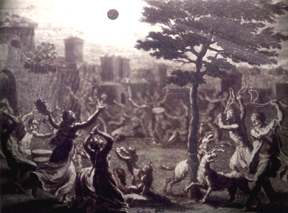This picture show how big sunspots are. Many sunspots are as big as Earth! Earth never really gets this close to the Sun; we just put Earth in the picture to show how large sunspots are.
Click on image for full size
Original Windows to the Universe artwork by Randy Russell using images from the Royal Swedish Academy of Sciences (sunspot image) and NASA (Earth image).
Sizes of Sunspots
Sunspots are very big
structures. They might look small compared to the Sun,
but remember the Sun has a diameter of 1.4 million km (870
thousand miles).
Most sunspots could swallow a planet! Many sunspots, like
the ones shown in the image on this page, are as large
as Earth! Most spots range in size from about 1,500 km (932 miles) to around
50,000 km (31,068 miles) in diameter. Once in a while, huge sunspots the size of Jupiter show up on the Sun's surface.
You might also be interested in:

Sunspots are dark, planet-sized regions that appear on the "surface" of the Sun. Sunspots are "dark" because they are colder than the areas around them. A large sunspot might have a temperature of about
...more
Most of the energy we receive from the Sun is the visible (white) light emitted from the photosphere. The photosphere is one of the coolest regions of the Sun (6000 K), so only a small fraction (0.1%)
...more
You may have heard of sunspots that sometimes dot the "surface" of the nearest star, our Sun. Well, other stars have spots too. They are called starspots and are relatively cool, dark regions on the visible
...more
Rising above the Sun's chromosphere , the temperature jumps sharply from a few tens of thousands of kelvins to as much as a few million kelvins in the Sun's outer atmosphere, the solar corona. Understanding
...more
Eclipses have been watched for centuries, but it was only recently that we understood what really occurs. Eclipses have always been fascinating to watch, but they weren't always welcome. For many years,
...more
An eclipse of the Sun occurs when the Earth passes through the Moon's shadow. A total eclipse of the Sun takes place only during a new moon, when the Moon is directly between the Sun and the Earth. When
...more
The gas in the solar corona is at very high temperatures (typically 1-2 million kelvins in most regions) so it is almost completely in a plasma state (made up of charged particles, mostly protons and electrons).
...more















